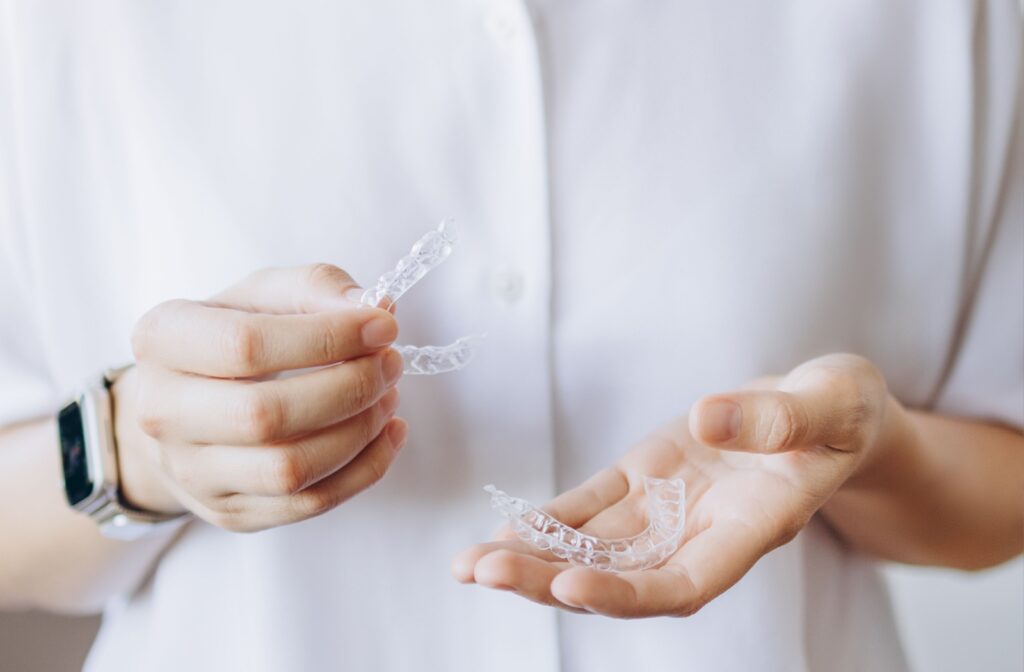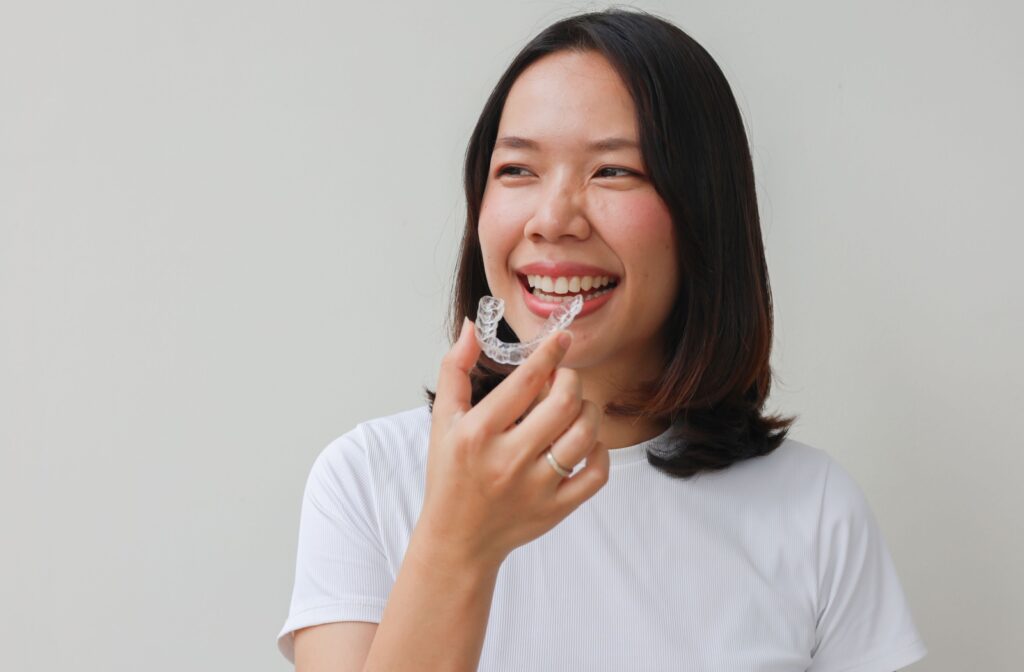When you’re thinking about straightening your teeth, two popular options often come to mind: Invisalign and traditional braces. Both can help you achieve a healthier, more aligned smile, but they work in very different ways. Understanding these differences is the first step in deciding which path is right for you.
There isn’t a single answer that fits everyone. The “better” option depends entirely on your unique dental needs, your lifestyle, and your personal smile goals. By exploring how each treatment works, you can make an informed choice for yourself or your family.
How Each Treatment Works to Straighten Your Smile
The Invisalign Method: Clear & Removable Aligners
Invisalign treatment uses a series of clear, custom-made plastic trays called aligners. You wear each set for about one to two weeks, during which time they gently shift your teeth into the desired position. After this period, your aligners are switched out for another set, and the process repeats, with your teeth gradually moving each time.
The Braces Method: Brackets & Wires
Traditional braces use small brackets that are attached to each tooth. A thin metal wire, known as an archwire, connects the brackets. This system applies continuous pressure to guide your teeth into proper alignment over time.
Appearance, Comfort & Daily Lifestyle
How Noticeable Are They?
The clear plastic of Invisalign aligners makes them discreet. Many people may not even realize you’re wearing them. Attachments (small, tooth-coloured dots placed on teeth to help the aligners grip) can sometimes make them a bit more visible.
Braces are more noticeable, but you still have options beyond traditional metal. For instance, ceramic braces use clear or tooth-coloured brackets that blend in with your teeth, making them a less obvious choice.
Which Option Feels More Comfortable?
Because Invisalign aligners are made of smooth plastic, they typically don’t irritate your cheeks or gums. You might feel some pressure or mild discomfort for a day or two after switching to a new set. This feeling is a sign that your treatment is working.
The brackets and wires of braces can sometimes rub against the inside of your mouth, which may cause temporary soreness. This usually subsides as your mouth adjusts. Dental wax can help provide relief during this period.
Food Freedom vs. Food Restrictions
With Invisalign, you need to remove your aligners to eat and drink anything other than cool water. This means you have no food restrictions. You can continue to enjoy all your favourite foods throughout your treatment.
When you have braces, you need to avoid certain foods that can damage the brackets or wires. These often include:
- Hard foods like nuts or hard candies
- Sticky foods like caramel or gum
- Chewy foods like tough bread or bagels
Oral Hygiene & Your Responsibilities
Cleaning your teeth with Invisalign is straightforward. You just take out your aligners to brush and floss as you normally would. You also need to clean the aligners themselves to keep them fresh.
Brushing and flossing with braces requires more care. You need to clean around each bracket and under the wire to remove food particles and prevent plaque buildup. Special tools can help make this process easier.
Successful Invisalign treatment depends on you. You need to wear the aligners for 20 to 22 hours every day. Forgetting to put them back in can slow down your progress.

Is Invisalign Faster Than Braces?
Factors That Influence Treatment Time
The main factor that determines your treatment length is the complexity of your dental needs. Simpler cases, like minor crooked teeth or small gaps, often take less time to correct than more complex bite issues. Everyone’s smile responds to treatment differently.
Typical Timelines for Both Options
For many mild to moderate cases, Invisalign treatment can take between 12 and 18 months. Some simpler treatments can be even shorter. Your timeline is planned out from the very beginning.
The treatment time for braces can range from one to two years, though this varies greatly depending on the person’s situation. More complex cases may require a longer period. Your dentist will give you a clear estimate.
Your Role in the Treatment Speed
Your progress depends on following your treatment plan. With Invisalign, this means wearing your aligners as directed. With braces, it means attending all your appointments, so your dentist can make adjustments.
Treatment Suitability & Effectiveness
What Dental Issues Can Invisalign Correct?
Invisalign is often a great option for people with mild to moderate cosmetic dental concerns. It can effectively address issues such as:
- Slightly crowded or crooked teeth
- Small gaps between teeth
- Some mild overbite, underbite, or crossbite issues
When Are Braces the Recommended Choice?
Braces may be recommended for more complex orthodontic cases. These situations can include:
- Severe crowding or spacing issues
- Significant bite problems
- Cases that require rotating teeth or moving them vertically
A Look at Cost & Appointments
Compare Invisalign & Braces Costs
The cost of Invisalign is often comparable to the cost of braces in Canada. The final price depends on how many aligners you’ll need and the total length of your treatment. Many dental insurance plans can help cover a portion of the cost.
The cost of braces also varies based on the type you choose—metal or ceramic—and the complexity of your case. We can provide a clear breakdown of costs during a consultation.
Office Visits & Adjustments
With Invisalign, you’ll have check-up appointments every six to eight weeks. These visits allow us to monitor your progress and give you your next set of aligners. The appointments are typically quick.
Braces require adjustment appointments about every four to six weeks. During these visits, the wires are adjusted to continue guiding your teeth. Regular check-ins are key to keeping your treatment on track.
The choice between Invisalign and braces depends on your specific needs, lifestyle, and preferences. Thinking about what matters most to you, whether it’s appearance, convenience, or the type of correction you need, can help guide your decision. The best first step is a conversation about your goals. At Shin Dentistry in Stoufville, we’re here to help you explore your options and decide which path will work best for your smile. Contact our team to schedule a consultation today.



